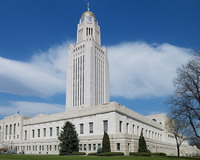Login form
Nebraska

Nebraska is nicknamed the Cornhusker State. A cornhusker is someone who harvested, or husked, corn by hand. Corn is an important crop in Nebraska. Farmers had to harvest corn by hand before there was a machine to do this work.
The University of Nebraska football team was called the Cornhuskers before the state adopted the nickname in 1945. Lots of college teams use their state’s nickname for their sports teams. In Nebraska, however, the state took its nickname from the football team.
|
Facts About Nebraska |
|
|
|
|
|
Capital |
Lincoln |
|
Population |
1,740,000 people |
|
Rank among states in population |
38th |
|
Major cities |
Omaha, Lincoln |
|
Area |
77,400 square miles |
|
Rank among states in area |
16th |
|
Statehood |
March 1, 1867, the 37th state |
|
State nickname |
The Cornhusker State |
|
Name for residents |
Nebraskans |
|
State bird |
Western Meadowlark |
|
State flower |
Goldenrod |
|
State tree |
Cottonwood |
|
Abbreviation |
NE |
THE TREE PLANTERS’ STATE
Until 1945, Nebraska was nicknamed the Tree Planters’ State. When early pioneers came to Nebraska, they found hardly any trees on the plains. The pioneers dug up chunks of sod (earth) to build their houses because they had no wood. Sod became known as Nebraska marble. Early settlers on the plains became known as sodbusters.
Settlers planted trees around their farms. Trees broke up the fierce winds that howled across the prairie. Trees provided firewood and fruit.
Nebraska was the first state to celebrate Arbor Day, a holiday devoted to planting trees. In 1872, a Nebraska newspaper editor, J. Sterling Morton, came up with the idea. More than a million trees were planted in Nebraska on April 10, 1872, the first Arbor Day. In 1885, the date of Arbor Day was changed to Morton’s birthday, April 22. Many other states also adopted the holiday. Most states now observe Arbor Day on the last Friday in April.
THE PLATTE RIVER—A ROUTE TO STATEHOOD
The Platte River flows east through Nebraska. It empties into the Missouri River near Omaha, Nebraska. Native Americans living near the Platte called it the Nebrathka, which means “flat water.” White explorers soon began to call the entire region Nebraska.
The Platte River helped Nebraska become a state. The Platte served as a westward route for pioneers. The Oregon Trail followed the Platte River because the flat river valley was easy to travel. Two landmarks in western Nebraska—Scotts Bluff and Chimney Rock—helped the wagon trains find their way. You can still see ruts left by wagon wheels in the river valley.
The Pony Express, the Union Pacific Railroad, and the first paved highway across the United States (U.S. 30) followed the Platte. Today the Platte valley still serves as an east-west transportation route. The Platte is too shallow for ships, however. Early settlers said the river was “a mile wide and an inch deep.”
Nebraska became the 37th state on March 1, 1867. Its capital is Lincoln, named in honor of U.S. president Abraham Lincoln. Omaha, the largest city in the state, lies on the Missouri River. Omaha grew in importance when the Union Pacific Railroad was built westward from it.
BOYS TOWN
Boys Town, a place for troubled boys and girls, is just west of Omaha. In 1917, Father Edward Joseph Flanagan started the Home for Homeless Boys in Omaha. Father Flanagan was Roman Catholic, but the home was for boys of all religions. The boys governed themselves by voting on important issues. By 1921, the home had become too crowded. It moved to Overlook Farm near Omaha. In 1926, the boys voted to rename the farm Boys Town. It became a village of its own.
Boys Town continued to grow. In 1979, girls were accepted into the program. Today, there are Girls and Boys Town homes in more than a dozen states. Boys and girls with problems can go to these homes to live and learn. The village of Boys Town remains the largest of these homes. Today it’s a National Historic Landmark.
KOOL-AID
Did you know that Kool-Aid was invented in Hastings, Nebraska? When Edwin Perkins was still a boy, he became interested in chemistry and business. He developed a drink called Fruit Smack that was sold in a bottle. It was expensive to ship, and sometimes the bottles broke. In 1927, Perkins found a way to remove the water from Fruit Smack. He packaged the remaining powder in an envelope. He called the powdered mix Kool Ade. Later, he changed the name to Kool-Aid.
SAND HILLS
About one-quarter of Nebraska is covered by the Sand Hills. It’s easy to figure out how the area got its name. The soil is very sandy. Grass grows on most of it, but occasionally you’ll find a sand dune. Before Nebraska was settled, herds of bison fed on the long grasses found in this area. Today, cattle graze in the Sand Hills.
Each spring, about half a million sandhill cranes stop on the Platte River just south of the Sand Hills. The birds rest and feed on their migration northward from their wintering grounds. Thousands of birdwatchers flock to Nebraska to see this spectacular sight.
OGALLALA AQUIFER
An aquifer is an underground water source. Nebraska sits over the huge Ogallala Aquifer. Much of Nebraska is too dry to grow crops without irrigation. Nearly four-fifths of Nebraska’s irrigation comes from this aquifer. Farmers pump water from deep wells. About 95 percent of Nebraska’s land is used for farming or grazing cattle.
WILLA CATHER
American writer Willa Cather grew up in Red Cloud, Nebraska. She wrote about Nebraska’s immigrant farm families in several of her books. My Ántonia is considered the best of her Nebraska books. In Red Cloud, you can visit Cather’s childhood home and the farm that she describes in My Ántonia.
Source: Microsoft ® Encarta

